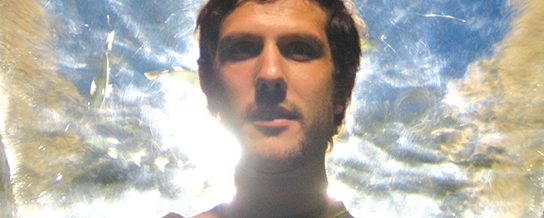Kelpe: To Downtempo’s Deepest End
For years, beat heads have waited for an answer to DJ Shadow’s Endtroducing, the downtempo […]

Kelpe: To Downtempo’s Deepest End
For years, beat heads have waited for an answer to DJ Shadow’s Endtroducing, the downtempo […]

For years, beat heads have waited for an answer to DJ Shadow’s Endtroducing, the downtempo masterpiece that helped change the world’s view of sample-based music. Shadow’s script has been flipped time and again since 1996, from RJD2’s more resolutely polished funk loops to Four Tet’s quirky, near-folky cut ‘n’ pastes to Eliot Lipp’s synth-heavy G Funk. But few have come as close to Endtroducing’s multi-layered moods and atmospheres–that head-nodding bass thump, those easy tempos, them crispy snares–as London artist Kelpe does with Ex-Aquarium.
Kelpe, born Kel McKeown, isn’t working inside the instrumental hip-hop idiom. He’s got his own thing going–call it… a life aquatic. From his debut album, 2004’s Sea Inside Body, McKeown has explored water themes, with tidal synths washing over tangled tendrils of guitar, luminescent hi-hats, and coral-sharp drum kicks. On Ex-Aquarium, these references are even more explicit, from the seagull samples in the ebbing and flowing “Whirlwound” to the enigmatic deep-sea cover art by Thogdin Ripley.
“Some of the tracks on the album have an overgrown feel to them, maybe because I was working on them for too long a period of time,” says McKeown, when asked to explain the album’s title. “I also had a vague notion of something that used to be an aquarium–an ex-aquarium–but all the fish died and it got all festering and full of overgrown oddities.”
He explains that this album’s more unkempt melodies and drums have a lot to do with changes in his recording process. Following his 2005 EP, Sunburnt Eyelids, he moved operations from a flat with paper-thin walls to a friend’s studio, where he began messing around with a drum kit, analog synths, and microphones. “Because I had recorded bits as audio instead of MIDI there was less opportunity to fiddle about intricately with all the melodies, so I got into arranging more natural percussive rhythms and letting them be much looser,” he offers. “When I was making Sea Inside Body, my slight lack of experience and confidence meant I had to keep the tracks quite neatly structured so I could keep control of them, but I would like to think I let things get a little more out of control on the new album.”
Though Kelpe is often compared to Boards of Canada–both deal in faraway-sounding sediments of sound, wistful melodies, and vocal samples from archival radio programs and children’s records–his inspirations actually lie somewhere in between Shadow and the utterly ambient soundscapes of Stars of the Lid. “Hearing a lot of the old Mo’ Wax stuff got me excited about what can be done with sampling, re-arranging beats, and using a more open-minded palette of sounds, but The Tired Sounds of Stars of the Lid really opened me up to the idea of a different kind of music: completely beat-less and stretched out over long periods of time to wash over you in a subconscious way.”

